Economics Assignment: Impact of Changes on Australian Iron Ore Mining
VerifiedAdded on 2020/03/23
|16
|4026
|44
Report
AI Summary
This report delves into the Australian iron ore mining industry, examining its substantial contribution to the nation's GDP and its significance as a primary industry. It explores the industry's impact on employment, regional economic activity, and government revenue through taxes and royalties. The report analyzes the role of the government in supporting the mining sector, including infrastructure investment and various programs. Furthermore, it assesses the effects of several economic changes, such as AUD depreciation, inflation rate increases, and rising global oil prices, on the industry's performance and the broader economy. The report also includes tables and figures illustrating key aspects of the industry's production and contribution to different states and territories.
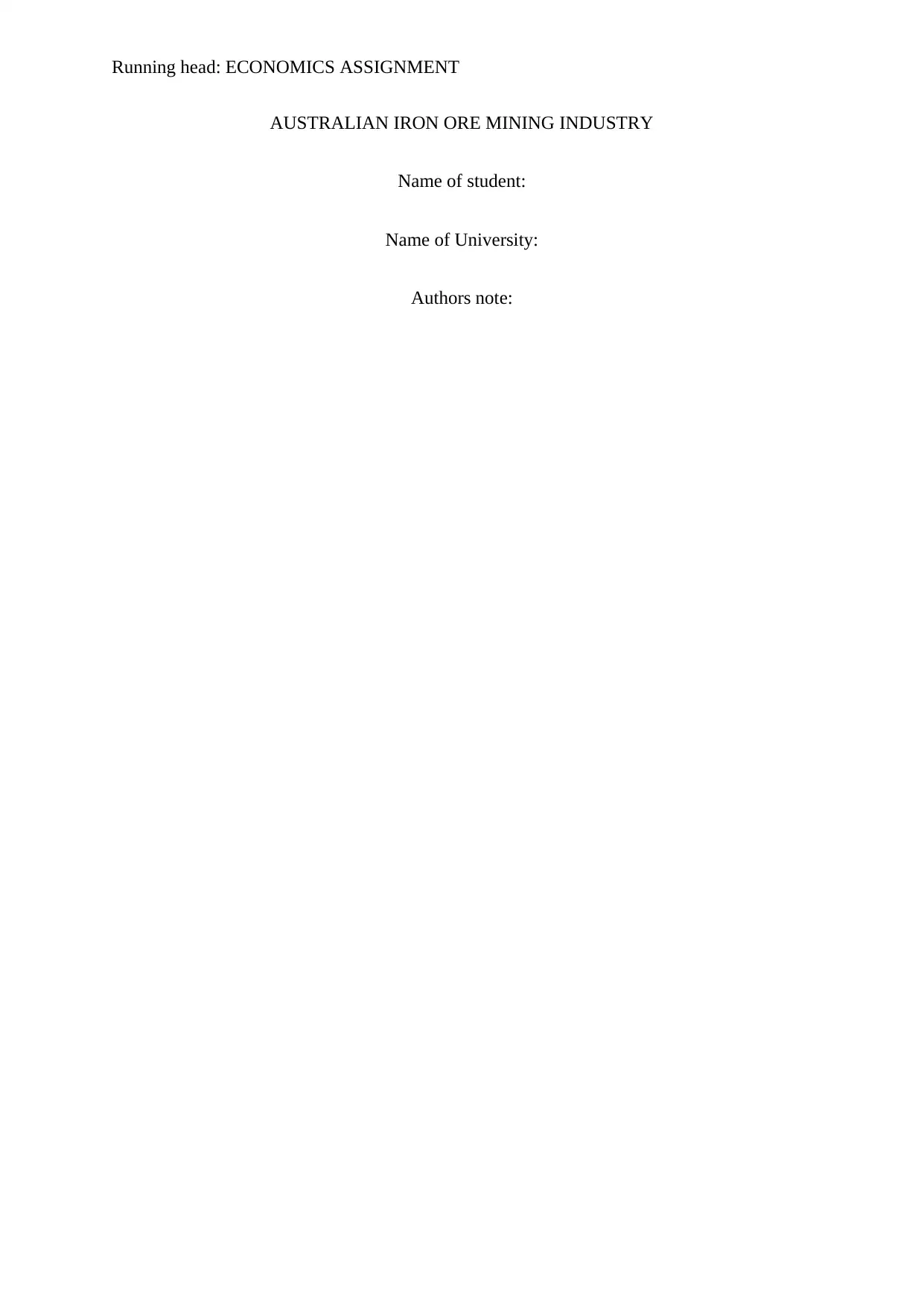
Running head: ECONOMICS ASSIGNMENT
AUSTRALIAN IRON ORE MINING INDUSTRY
Name of student:
Name of University:
Authors note:
AUSTRALIAN IRON ORE MINING INDUSTRY
Name of student:
Name of University:
Authors note:
Paraphrase This Document
Need a fresh take? Get an instant paraphrase of this document with our AI Paraphraser
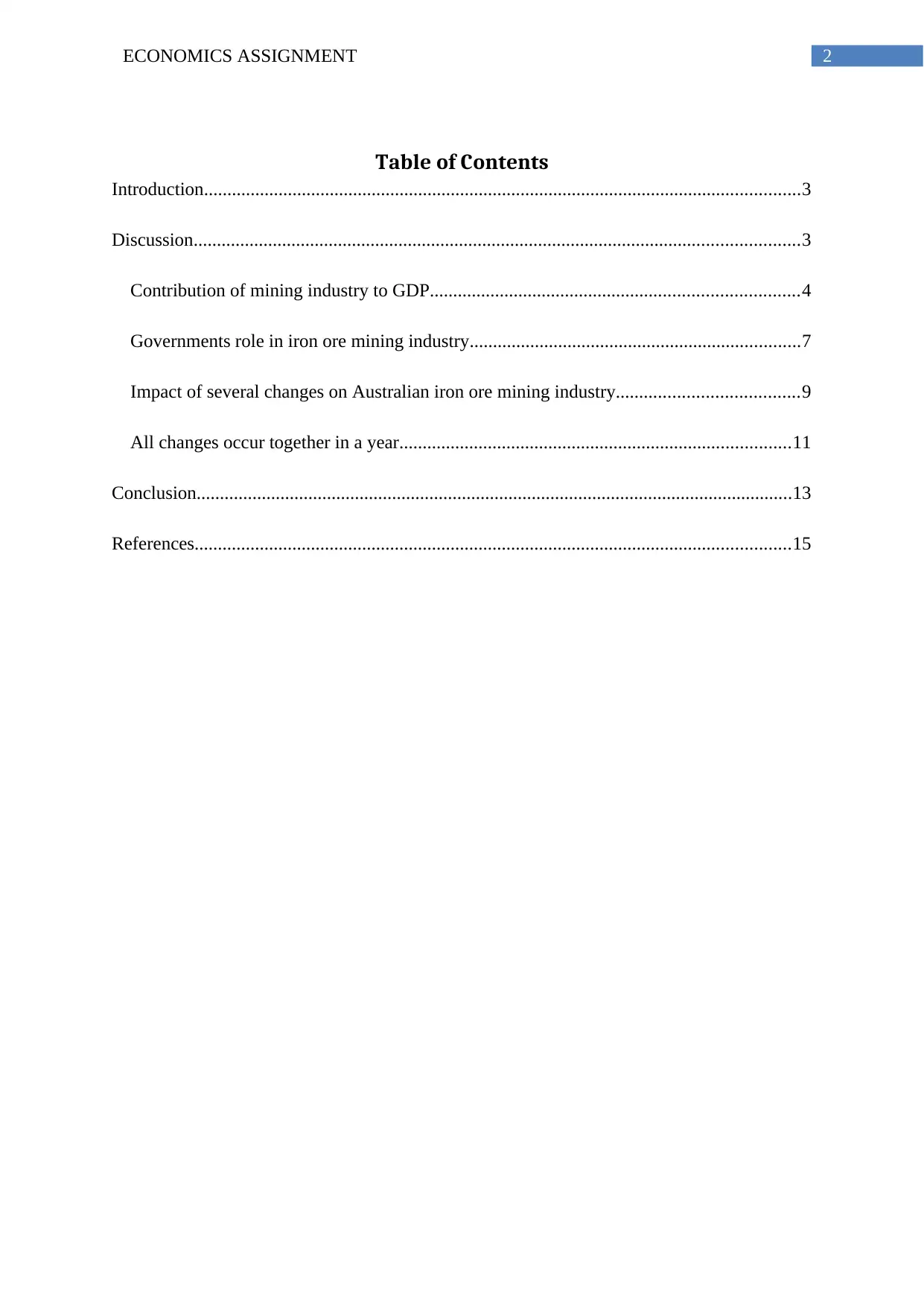
2ECONOMICS ASSIGNMENT
Table of Contents
Introduction................................................................................................................................3
Discussion..................................................................................................................................3
Contribution of mining industry to GDP...............................................................................4
Governments role in iron ore mining industry.......................................................................7
Impact of several changes on Australian iron ore mining industry.......................................9
All changes occur together in a year....................................................................................11
Conclusion................................................................................................................................13
References................................................................................................................................15
Table of Contents
Introduction................................................................................................................................3
Discussion..................................................................................................................................3
Contribution of mining industry to GDP...............................................................................4
Governments role in iron ore mining industry.......................................................................7
Impact of several changes on Australian iron ore mining industry.......................................9
All changes occur together in a year....................................................................................11
Conclusion................................................................................................................................13
References................................................................................................................................15
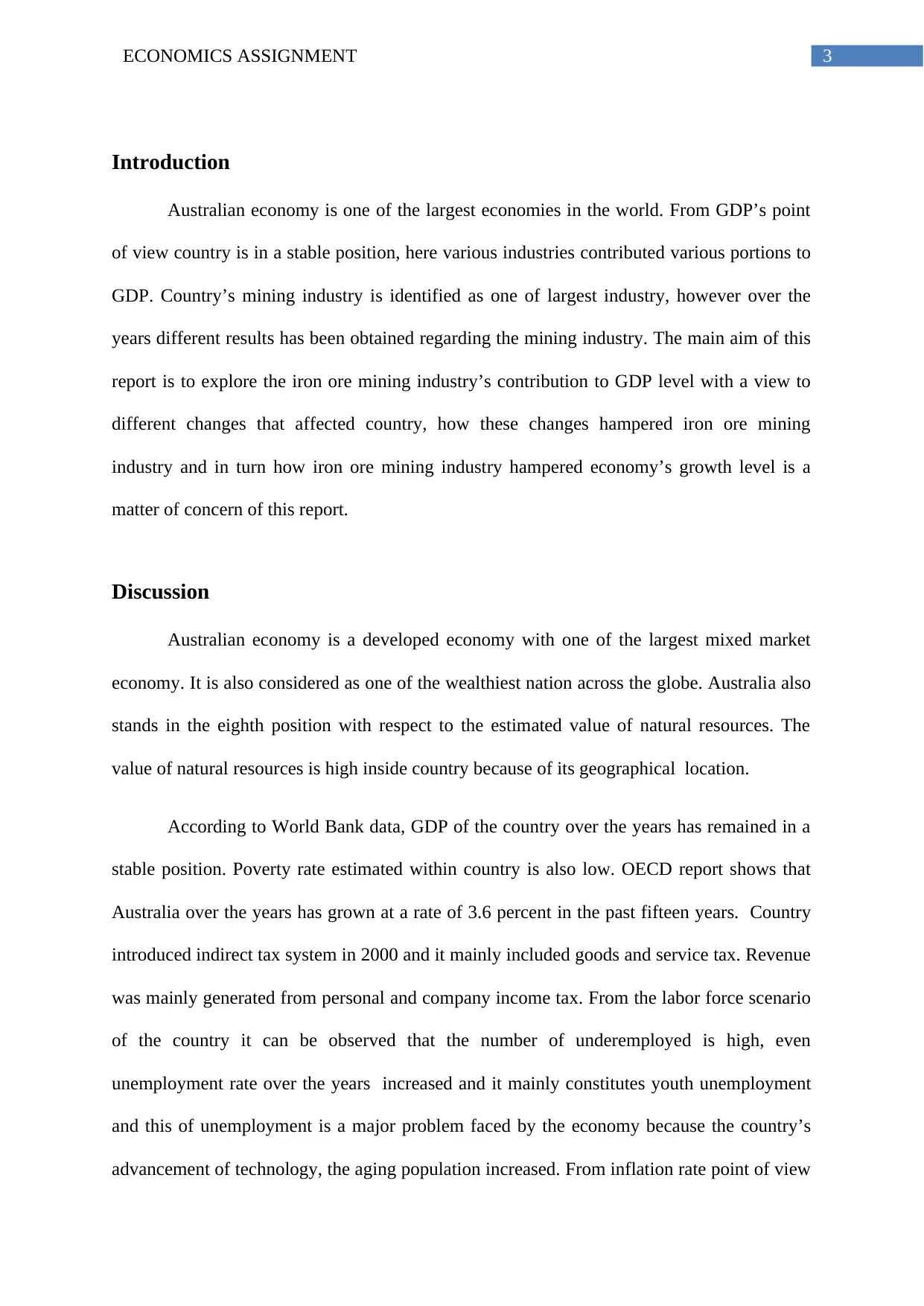
3ECONOMICS ASSIGNMENT
Introduction
Australian economy is one of the largest economies in the world. From GDP’s point
of view country is in a stable position, here various industries contributed various portions to
GDP. Country’s mining industry is identified as one of largest industry, however over the
years different results has been obtained regarding the mining industry. The main aim of this
report is to explore the iron ore mining industry’s contribution to GDP level with a view to
different changes that affected country, how these changes hampered iron ore mining
industry and in turn how iron ore mining industry hampered economy’s growth level is a
matter of concern of this report.
Discussion
Australian economy is a developed economy with one of the largest mixed market
economy. It is also considered as one of the wealthiest nation across the globe. Australia also
stands in the eighth position with respect to the estimated value of natural resources. The
value of natural resources is high inside country because of its geographical location.
According to World Bank data, GDP of the country over the years has remained in a
stable position. Poverty rate estimated within country is also low. OECD report shows that
Australia over the years has grown at a rate of 3.6 percent in the past fifteen years. Country
introduced indirect tax system in 2000 and it mainly included goods and service tax. Revenue
was mainly generated from personal and company income tax. From the labor force scenario
of the country it can be observed that the number of underemployed is high, even
unemployment rate over the years increased and it mainly constitutes youth unemployment
and this of unemployment is a major problem faced by the economy because the country’s
advancement of technology, the aging population increased. From inflation rate point of view
Introduction
Australian economy is one of the largest economies in the world. From GDP’s point
of view country is in a stable position, here various industries contributed various portions to
GDP. Country’s mining industry is identified as one of largest industry, however over the
years different results has been obtained regarding the mining industry. The main aim of this
report is to explore the iron ore mining industry’s contribution to GDP level with a view to
different changes that affected country, how these changes hampered iron ore mining
industry and in turn how iron ore mining industry hampered economy’s growth level is a
matter of concern of this report.
Discussion
Australian economy is a developed economy with one of the largest mixed market
economy. It is also considered as one of the wealthiest nation across the globe. Australia also
stands in the eighth position with respect to the estimated value of natural resources. The
value of natural resources is high inside country because of its geographical location.
According to World Bank data, GDP of the country over the years has remained in a
stable position. Poverty rate estimated within country is also low. OECD report shows that
Australia over the years has grown at a rate of 3.6 percent in the past fifteen years. Country
introduced indirect tax system in 2000 and it mainly included goods and service tax. Revenue
was mainly generated from personal and company income tax. From the labor force scenario
of the country it can be observed that the number of underemployed is high, even
unemployment rate over the years increased and it mainly constitutes youth unemployment
and this of unemployment is a major problem faced by the economy because the country’s
advancement of technology, the aging population increased. From inflation rate point of view
⊘ This is a preview!⊘
Do you want full access?
Subscribe today to unlock all pages.

Trusted by 1+ million students worldwide
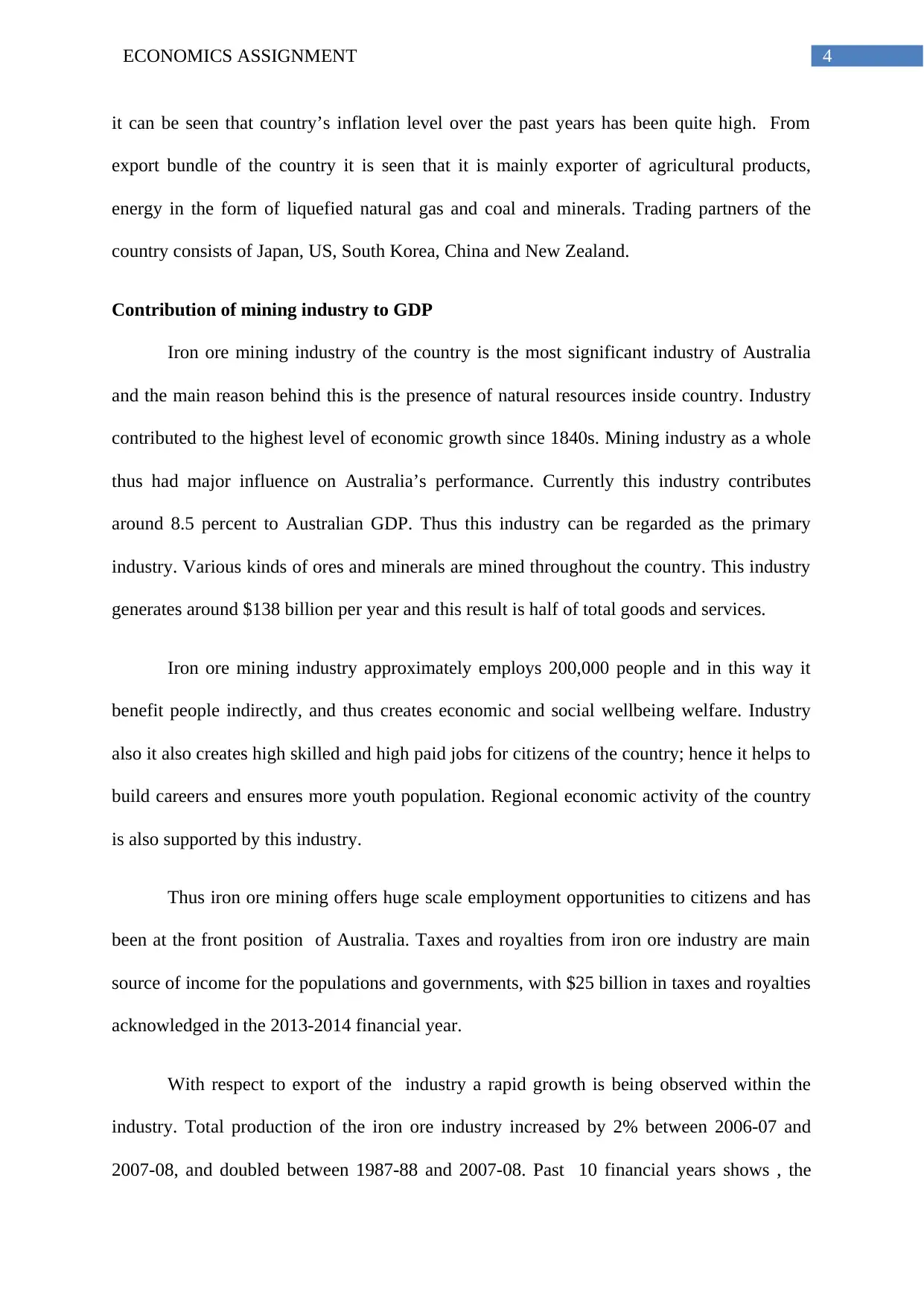
4ECONOMICS ASSIGNMENT
it can be seen that country’s inflation level over the past years has been quite high. From
export bundle of the country it is seen that it is mainly exporter of agricultural products,
energy in the form of liquefied natural gas and coal and minerals. Trading partners of the
country consists of Japan, US, South Korea, China and New Zealand.
Contribution of mining industry to GDP
Iron ore mining industry of the country is the most significant industry of Australia
and the main reason behind this is the presence of natural resources inside country. Industry
contributed to the highest level of economic growth since 1840s. Mining industry as a whole
thus had major influence on Australia’s performance. Currently this industry contributes
around 8.5 percent to Australian GDP. Thus this industry can be regarded as the primary
industry. Various kinds of ores and minerals are mined throughout the country. This industry
generates around $138 billion per year and this result is half of total goods and services.
Iron ore mining industry approximately employs 200,000 people and in this way it
benefit people indirectly, and thus creates economic and social wellbeing welfare. Industry
also it also creates high skilled and high paid jobs for citizens of the country; hence it helps to
build careers and ensures more youth population. Regional economic activity of the country
is also supported by this industry.
Thus iron ore mining offers huge scale employment opportunities to citizens and has
been at the front position of Australia. Taxes and royalties from iron ore industry are main
source of income for the populations and governments, with $25 billion in taxes and royalties
acknowledged in the 2013-2014 financial year.
With respect to export of the industry a rapid growth is being observed within the
industry. Total production of the iron ore industry increased by 2% between 2006-07 and
2007-08, and doubled between 1987-88 and 2007-08. Past 10 financial years shows , the
it can be seen that country’s inflation level over the past years has been quite high. From
export bundle of the country it is seen that it is mainly exporter of agricultural products,
energy in the form of liquefied natural gas and coal and minerals. Trading partners of the
country consists of Japan, US, South Korea, China and New Zealand.
Contribution of mining industry to GDP
Iron ore mining industry of the country is the most significant industry of Australia
and the main reason behind this is the presence of natural resources inside country. Industry
contributed to the highest level of economic growth since 1840s. Mining industry as a whole
thus had major influence on Australia’s performance. Currently this industry contributes
around 8.5 percent to Australian GDP. Thus this industry can be regarded as the primary
industry. Various kinds of ores and minerals are mined throughout the country. This industry
generates around $138 billion per year and this result is half of total goods and services.
Iron ore mining industry approximately employs 200,000 people and in this way it
benefit people indirectly, and thus creates economic and social wellbeing welfare. Industry
also it also creates high skilled and high paid jobs for citizens of the country; hence it helps to
build careers and ensures more youth population. Regional economic activity of the country
is also supported by this industry.
Thus iron ore mining offers huge scale employment opportunities to citizens and has
been at the front position of Australia. Taxes and royalties from iron ore industry are main
source of income for the populations and governments, with $25 billion in taxes and royalties
acknowledged in the 2013-2014 financial year.
With respect to export of the industry a rapid growth is being observed within the
industry. Total production of the iron ore industry increased by 2% between 2006-07 and
2007-08, and doubled between 1987-88 and 2007-08. Past 10 financial years shows , the
Paraphrase This Document
Need a fresh take? Get an instant paraphrase of this document with our AI Paraphraser
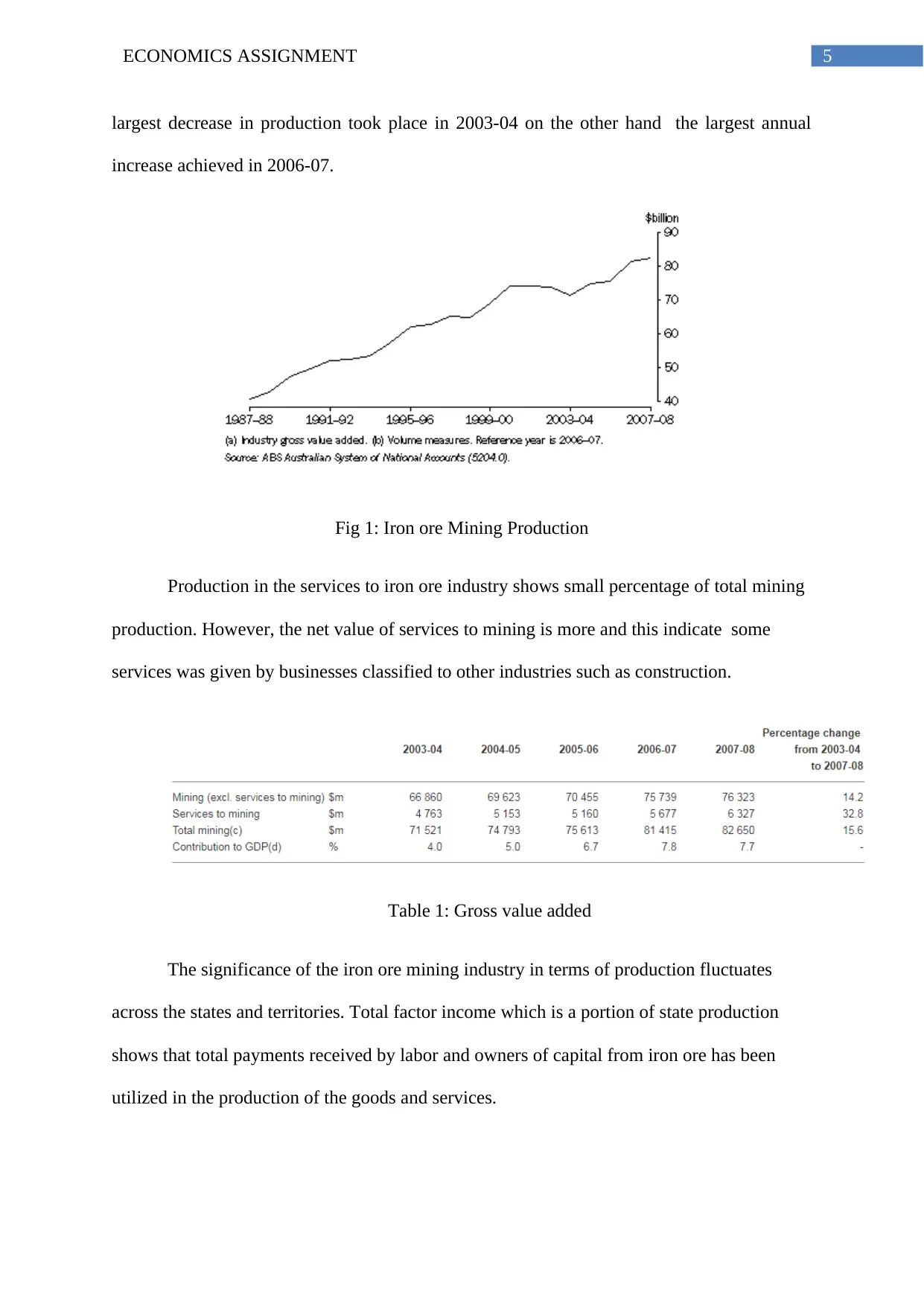
5ECONOMICS ASSIGNMENT
largest decrease in production took place in 2003-04 on the other hand the largest annual
increase achieved in 2006-07.
Fig 1: Iron ore Mining Production
Production in the services to iron ore industry shows small percentage of total mining
production. However, the net value of services to mining is more and this indicate some
services was given by businesses classified to other industries such as construction.
Table 1: Gross value added
The significance of the iron ore mining industry in terms of production fluctuates
across the states and territories. Total factor income which is a portion of state production
shows that total payments received by labor and owners of capital from iron ore has been
utilized in the production of the goods and services.
largest decrease in production took place in 2003-04 on the other hand the largest annual
increase achieved in 2006-07.
Fig 1: Iron ore Mining Production
Production in the services to iron ore industry shows small percentage of total mining
production. However, the net value of services to mining is more and this indicate some
services was given by businesses classified to other industries such as construction.
Table 1: Gross value added
The significance of the iron ore mining industry in terms of production fluctuates
across the states and territories. Total factor income which is a portion of state production
shows that total payments received by labor and owners of capital from iron ore has been
utilized in the production of the goods and services.
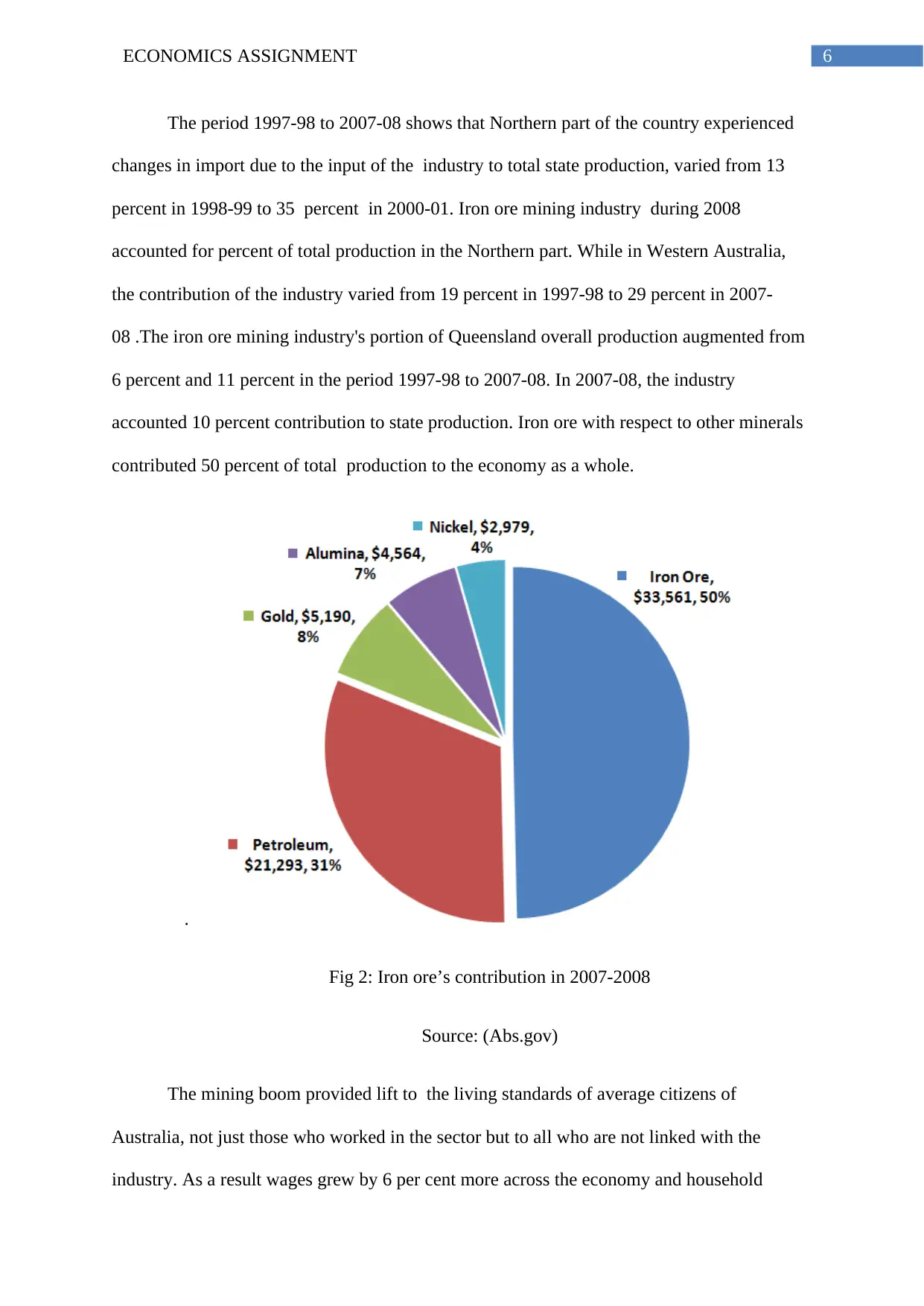
6ECONOMICS ASSIGNMENT
The period 1997-98 to 2007-08 shows that Northern part of the country experienced
changes in import due to the input of the industry to total state production, varied from 13
percent in 1998-99 to 35 percent in 2000-01. Iron ore mining industry during 2008
accounted for percent of total production in the Northern part. While in Western Australia,
the contribution of the industry varied from 19 percent in 1997-98 to 29 percent in 2007-
08 .The iron ore mining industry's portion of Queensland overall production augmented from
6 percent and 11 percent in the period 1997-98 to 2007-08. In 2007-08, the industry
accounted 10 percent contribution to state production. Iron ore with respect to other minerals
contributed 50 percent of total production to the economy as a whole.
.
Fig 2: Iron ore’s contribution in 2007-2008
Source: (Abs.gov)
The mining boom provided lift to the living standards of average citizens of
Australia, not just those who worked in the sector but to all who are not linked with the
industry. As a result wages grew by 6 per cent more across the economy and household
The period 1997-98 to 2007-08 shows that Northern part of the country experienced
changes in import due to the input of the industry to total state production, varied from 13
percent in 1998-99 to 35 percent in 2000-01. Iron ore mining industry during 2008
accounted for percent of total production in the Northern part. While in Western Australia,
the contribution of the industry varied from 19 percent in 1997-98 to 29 percent in 2007-
08 .The iron ore mining industry's portion of Queensland overall production augmented from
6 percent and 11 percent in the period 1997-98 to 2007-08. In 2007-08, the industry
accounted 10 percent contribution to state production. Iron ore with respect to other minerals
contributed 50 percent of total production to the economy as a whole.
.
Fig 2: Iron ore’s contribution in 2007-2008
Source: (Abs.gov)
The mining boom provided lift to the living standards of average citizens of
Australia, not just those who worked in the sector but to all who are not linked with the
industry. As a result wages grew by 6 per cent more across the economy and household
⊘ This is a preview!⊘
Do you want full access?
Subscribe today to unlock all pages.

Trusted by 1+ million students worldwide
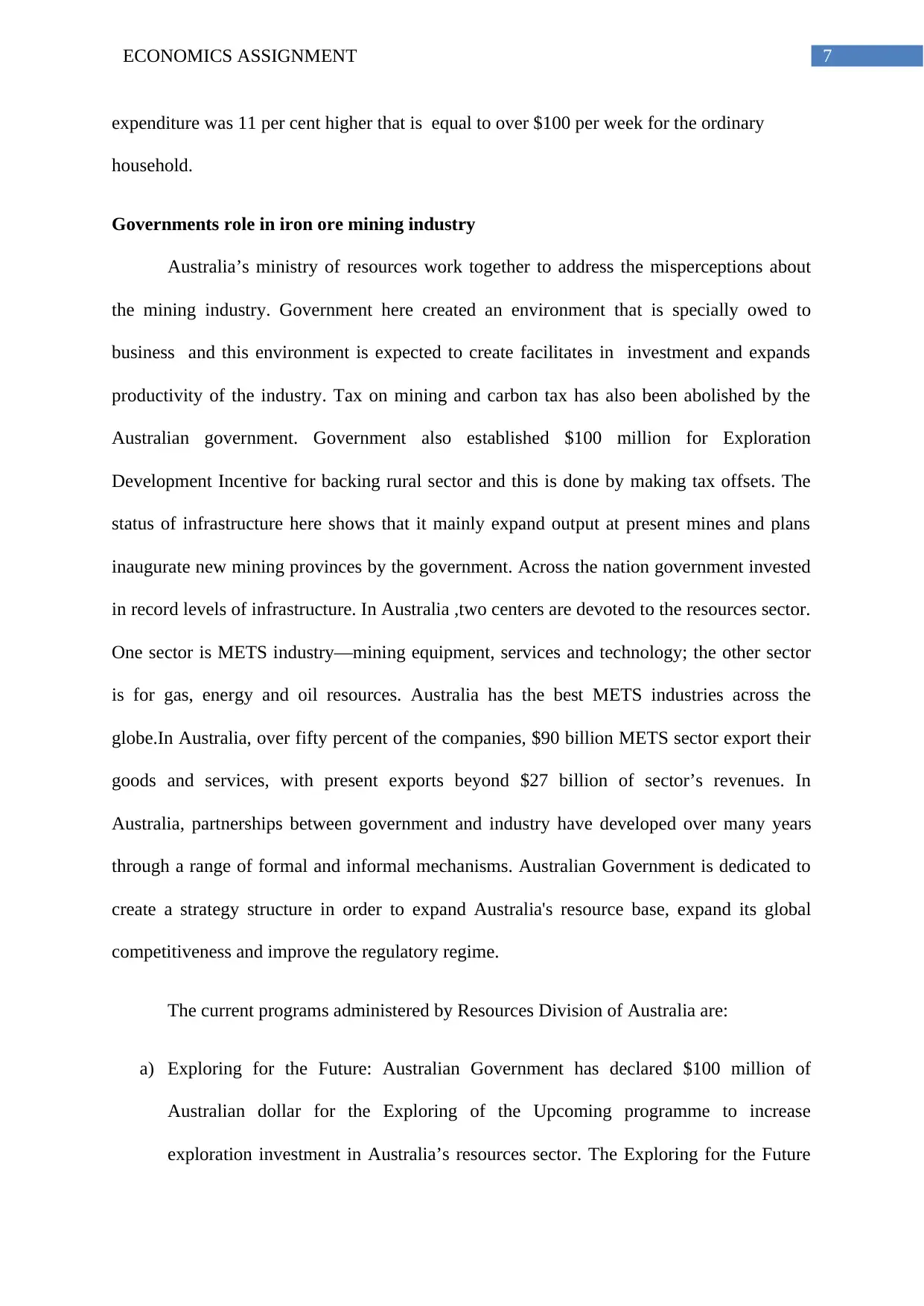
7ECONOMICS ASSIGNMENT
expenditure was 11 per cent higher that is equal to over $100 per week for the ordinary
household.
Governments role in iron ore mining industry
Australia’s ministry of resources work together to address the misperceptions about
the mining industry. Government here created an environment that is specially owed to
business and this environment is expected to create facilitates in investment and expands
productivity of the industry. Tax on mining and carbon tax has also been abolished by the
Australian government. Government also established $100 million for Exploration
Development Incentive for backing rural sector and this is done by making tax offsets. The
status of infrastructure here shows that it mainly expand output at present mines and plans
inaugurate new mining provinces by the government. Across the nation government invested
in record levels of infrastructure. In Australia ,two centers are devoted to the resources sector.
One sector is METS industry—mining equipment, services and technology; the other sector
is for gas, energy and oil resources. Australia has the best METS industries across the
globe.In Australia, over fifty percent of the companies, $90 billion METS sector export their
goods and services, with present exports beyond $27 billion of sector’s revenues. In
Australia, partnerships between government and industry have developed over many years
through a range of formal and informal mechanisms. Australian Government is dedicated to
create a strategy structure in order to expand Australia's resource base, expand its global
competitiveness and improve the regulatory regime.
The current programs administered by Resources Division of Australia are:
a) Exploring for the Future: Australian Government has declared $100 million of
Australian dollar for the Exploring of the Upcoming programme to increase
exploration investment in Australia’s resources sector. The Exploring for the Future
expenditure was 11 per cent higher that is equal to over $100 per week for the ordinary
household.
Governments role in iron ore mining industry
Australia’s ministry of resources work together to address the misperceptions about
the mining industry. Government here created an environment that is specially owed to
business and this environment is expected to create facilitates in investment and expands
productivity of the industry. Tax on mining and carbon tax has also been abolished by the
Australian government. Government also established $100 million for Exploration
Development Incentive for backing rural sector and this is done by making tax offsets. The
status of infrastructure here shows that it mainly expand output at present mines and plans
inaugurate new mining provinces by the government. Across the nation government invested
in record levels of infrastructure. In Australia ,two centers are devoted to the resources sector.
One sector is METS industry—mining equipment, services and technology; the other sector
is for gas, energy and oil resources. Australia has the best METS industries across the
globe.In Australia, over fifty percent of the companies, $90 billion METS sector export their
goods and services, with present exports beyond $27 billion of sector’s revenues. In
Australia, partnerships between government and industry have developed over many years
through a range of formal and informal mechanisms. Australian Government is dedicated to
create a strategy structure in order to expand Australia's resource base, expand its global
competitiveness and improve the regulatory regime.
The current programs administered by Resources Division of Australia are:
a) Exploring for the Future: Australian Government has declared $100 million of
Australian dollar for the Exploring of the Upcoming programme to increase
exploration investment in Australia’s resources sector. The Exploring for the Future
Paraphrase This Document
Need a fresh take? Get an instant paraphrase of this document with our AI Paraphraser
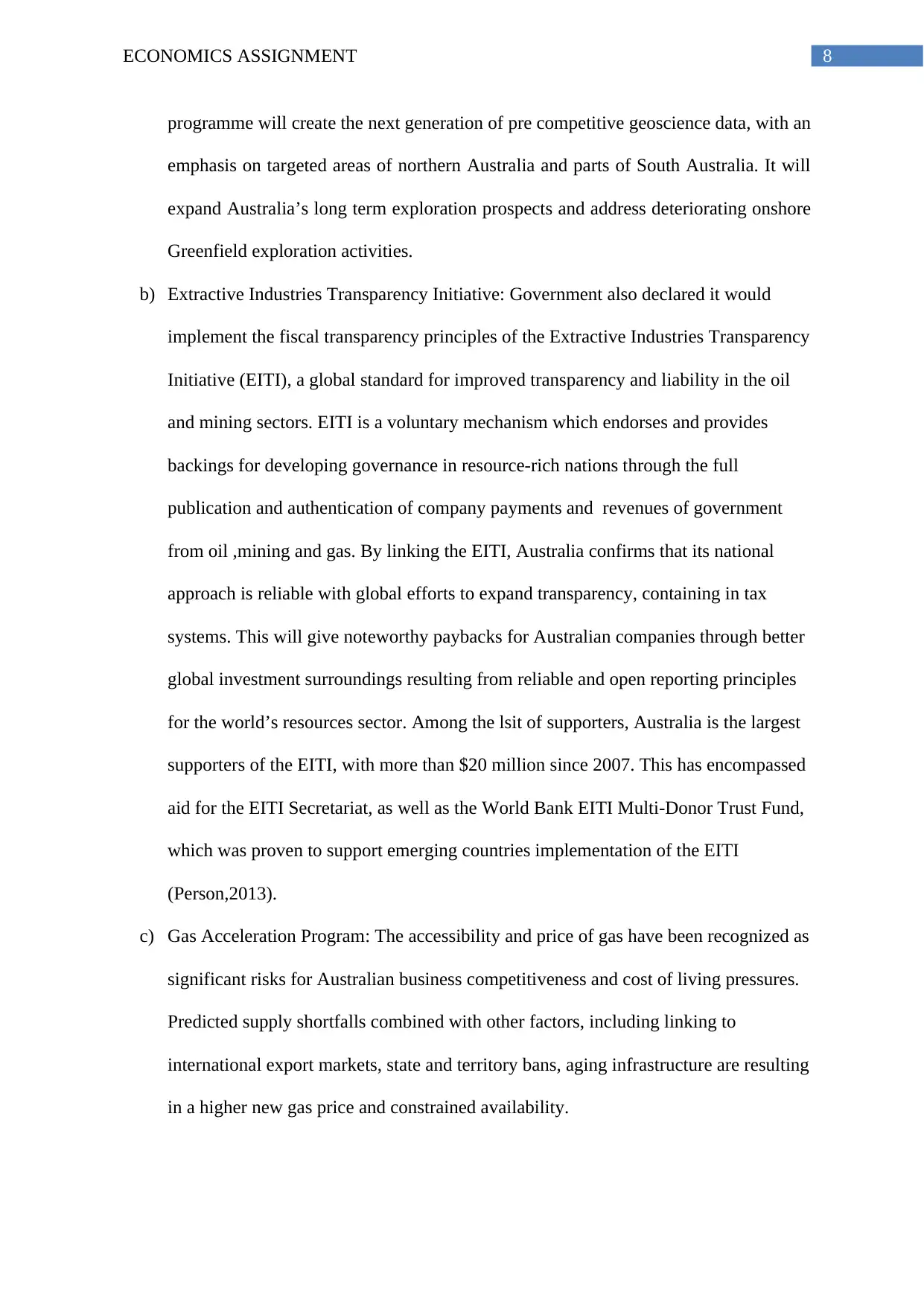
8ECONOMICS ASSIGNMENT
programme will create the next generation of pre competitive geoscience data, with an
emphasis on targeted areas of northern Australia and parts of South Australia. It will
expand Australia’s long term exploration prospects and address deteriorating onshore
Greenfield exploration activities.
b) Extractive Industries Transparency Initiative: Government also declared it would
implement the fiscal transparency principles of the Extractive Industries Transparency
Initiative (EITI), a global standard for improved transparency and liability in the oil
and mining sectors. EITI is a voluntary mechanism which endorses and provides
backings for developing governance in resource-rich nations through the full
publication and authentication of company payments and revenues of government
from oil ,mining and gas. By linking the EITI, Australia confirms that its national
approach is reliable with global efforts to expand transparency, containing in tax
systems. This will give noteworthy paybacks for Australian companies through better
global investment surroundings resulting from reliable and open reporting principles
for the world’s resources sector. Among the lsit of supporters, Australia is the largest
supporters of the EITI, with more than $20 million since 2007. This has encompassed
aid for the EITI Secretariat, as well as the World Bank EITI Multi-Donor Trust Fund,
which was proven to support emerging countries implementation of the EITI
(Person,2013).
c) Gas Acceleration Program: The accessibility and price of gas have been recognized as
significant risks for Australian business competitiveness and cost of living pressures.
Predicted supply shortfalls combined with other factors, including linking to
international export markets, state and territory bans, aging infrastructure are resulting
in a higher new gas price and constrained availability.
programme will create the next generation of pre competitive geoscience data, with an
emphasis on targeted areas of northern Australia and parts of South Australia. It will
expand Australia’s long term exploration prospects and address deteriorating onshore
Greenfield exploration activities.
b) Extractive Industries Transparency Initiative: Government also declared it would
implement the fiscal transparency principles of the Extractive Industries Transparency
Initiative (EITI), a global standard for improved transparency and liability in the oil
and mining sectors. EITI is a voluntary mechanism which endorses and provides
backings for developing governance in resource-rich nations through the full
publication and authentication of company payments and revenues of government
from oil ,mining and gas. By linking the EITI, Australia confirms that its national
approach is reliable with global efforts to expand transparency, containing in tax
systems. This will give noteworthy paybacks for Australian companies through better
global investment surroundings resulting from reliable and open reporting principles
for the world’s resources sector. Among the lsit of supporters, Australia is the largest
supporters of the EITI, with more than $20 million since 2007. This has encompassed
aid for the EITI Secretariat, as well as the World Bank EITI Multi-Donor Trust Fund,
which was proven to support emerging countries implementation of the EITI
(Person,2013).
c) Gas Acceleration Program: The accessibility and price of gas have been recognized as
significant risks for Australian business competitiveness and cost of living pressures.
Predicted supply shortfalls combined with other factors, including linking to
international export markets, state and territory bans, aging infrastructure are resulting
in a higher new gas price and constrained availability.
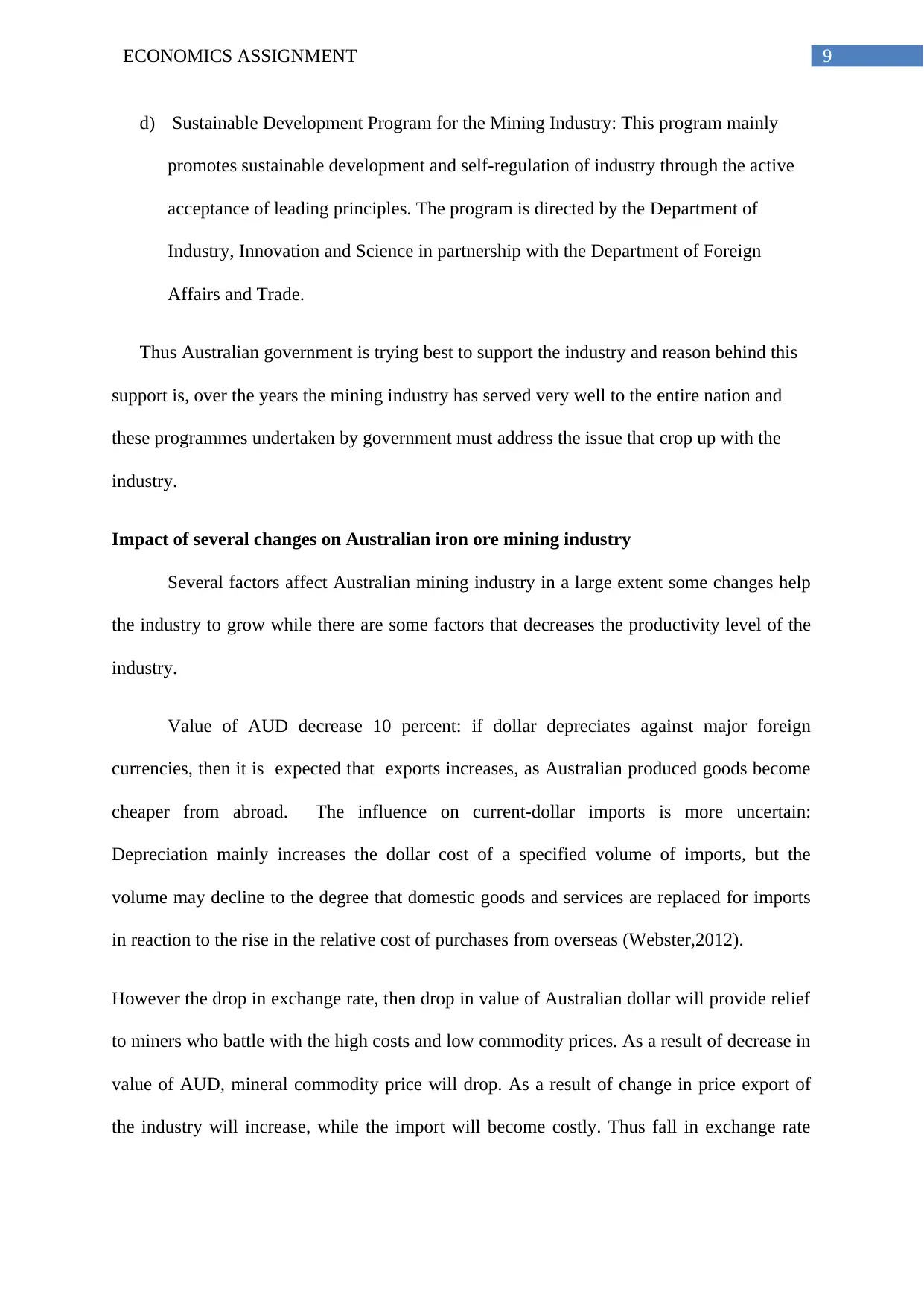
9ECONOMICS ASSIGNMENT
d) Sustainable Development Program for the Mining Industry: This program mainly
promotes sustainable development and self-regulation of industry through the active
acceptance of leading principles. The program is directed by the Department of
Industry, Innovation and Science in partnership with the Department of Foreign
Affairs and Trade.
Thus Australian government is trying best to support the industry and reason behind this
support is, over the years the mining industry has served very well to the entire nation and
these programmes undertaken by government must address the issue that crop up with the
industry.
Impact of several changes on Australian iron ore mining industry
Several factors affect Australian mining industry in a large extent some changes help
the industry to grow while there are some factors that decreases the productivity level of the
industry.
Value of AUD decrease 10 percent: if dollar depreciates against major foreign
currencies, then it is expected that exports increases, as Australian produced goods become
cheaper from abroad. The influence on current-dollar imports is more uncertain:
Depreciation mainly increases the dollar cost of a specified volume of imports, but the
volume may decline to the degree that domestic goods and services are replaced for imports
in reaction to the rise in the relative cost of purchases from overseas (Webster,2012).
However the drop in exchange rate, then drop in value of Australian dollar will provide relief
to miners who battle with the high costs and low commodity prices. As a result of decrease in
value of AUD, mineral commodity price will drop. As a result of change in price export of
the industry will increase, while the import will become costly. Thus fall in exchange rate
d) Sustainable Development Program for the Mining Industry: This program mainly
promotes sustainable development and self-regulation of industry through the active
acceptance of leading principles. The program is directed by the Department of
Industry, Innovation and Science in partnership with the Department of Foreign
Affairs and Trade.
Thus Australian government is trying best to support the industry and reason behind this
support is, over the years the mining industry has served very well to the entire nation and
these programmes undertaken by government must address the issue that crop up with the
industry.
Impact of several changes on Australian iron ore mining industry
Several factors affect Australian mining industry in a large extent some changes help
the industry to grow while there are some factors that decreases the productivity level of the
industry.
Value of AUD decrease 10 percent: if dollar depreciates against major foreign
currencies, then it is expected that exports increases, as Australian produced goods become
cheaper from abroad. The influence on current-dollar imports is more uncertain:
Depreciation mainly increases the dollar cost of a specified volume of imports, but the
volume may decline to the degree that domestic goods and services are replaced for imports
in reaction to the rise in the relative cost of purchases from overseas (Webster,2012).
However the drop in exchange rate, then drop in value of Australian dollar will provide relief
to miners who battle with the high costs and low commodity prices. As a result of decrease in
value of AUD, mineral commodity price will drop. As a result of change in price export of
the industry will increase, while the import will become costly. Thus fall in exchange rate
⊘ This is a preview!⊘
Do you want full access?
Subscribe today to unlock all pages.

Trusted by 1+ million students worldwide
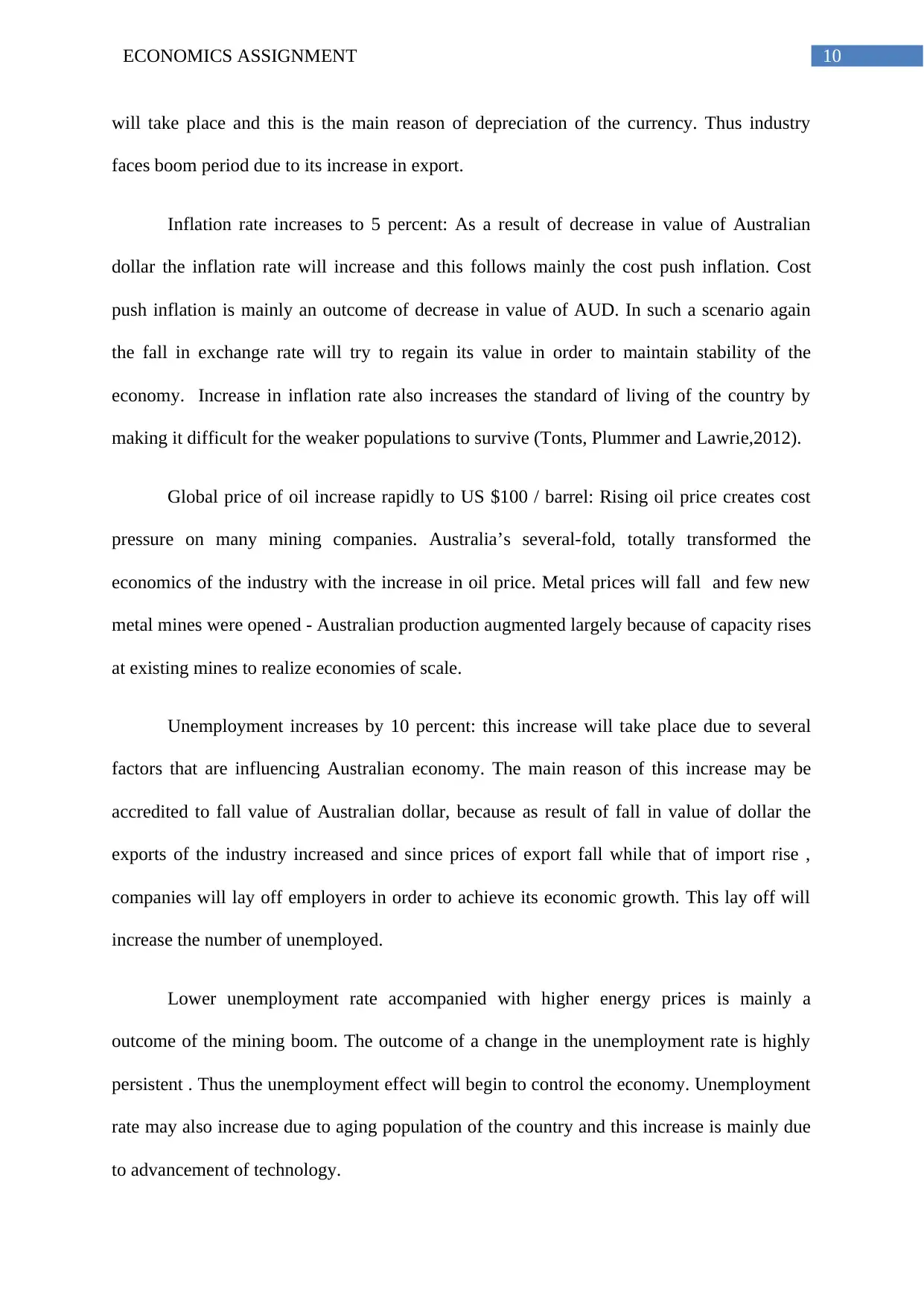
10ECONOMICS ASSIGNMENT
will take place and this is the main reason of depreciation of the currency. Thus industry
faces boom period due to its increase in export.
Inflation rate increases to 5 percent: As a result of decrease in value of Australian
dollar the inflation rate will increase and this follows mainly the cost push inflation. Cost
push inflation is mainly an outcome of decrease in value of AUD. In such a scenario again
the fall in exchange rate will try to regain its value in order to maintain stability of the
economy. Increase in inflation rate also increases the standard of living of the country by
making it difficult for the weaker populations to survive (Tonts, Plummer and Lawrie,2012).
Global price of oil increase rapidly to US $100 / barrel: Rising oil price creates cost
pressure on many mining companies. Australia’s several-fold, totally transformed the
economics of the industry with the increase in oil price. Metal prices will fall and few new
metal mines were opened - Australian production augmented largely because of capacity rises
at existing mines to realize economies of scale.
Unemployment increases by 10 percent: this increase will take place due to several
factors that are influencing Australian economy. The main reason of this increase may be
accredited to fall value of Australian dollar, because as result of fall in value of dollar the
exports of the industry increased and since prices of export fall while that of import rise ,
companies will lay off employers in order to achieve its economic growth. This lay off will
increase the number of unemployed.
Lower unemployment rate accompanied with higher energy prices is mainly a
outcome of the mining boom. The outcome of a change in the unemployment rate is highly
persistent . Thus the unemployment effect will begin to control the economy. Unemployment
rate may also increase due to aging population of the country and this increase is mainly due
to advancement of technology.
will take place and this is the main reason of depreciation of the currency. Thus industry
faces boom period due to its increase in export.
Inflation rate increases to 5 percent: As a result of decrease in value of Australian
dollar the inflation rate will increase and this follows mainly the cost push inflation. Cost
push inflation is mainly an outcome of decrease in value of AUD. In such a scenario again
the fall in exchange rate will try to regain its value in order to maintain stability of the
economy. Increase in inflation rate also increases the standard of living of the country by
making it difficult for the weaker populations to survive (Tonts, Plummer and Lawrie,2012).
Global price of oil increase rapidly to US $100 / barrel: Rising oil price creates cost
pressure on many mining companies. Australia’s several-fold, totally transformed the
economics of the industry with the increase in oil price. Metal prices will fall and few new
metal mines were opened - Australian production augmented largely because of capacity rises
at existing mines to realize economies of scale.
Unemployment increases by 10 percent: this increase will take place due to several
factors that are influencing Australian economy. The main reason of this increase may be
accredited to fall value of Australian dollar, because as result of fall in value of dollar the
exports of the industry increased and since prices of export fall while that of import rise ,
companies will lay off employers in order to achieve its economic growth. This lay off will
increase the number of unemployed.
Lower unemployment rate accompanied with higher energy prices is mainly a
outcome of the mining boom. The outcome of a change in the unemployment rate is highly
persistent . Thus the unemployment effect will begin to control the economy. Unemployment
rate may also increase due to aging population of the country and this increase is mainly due
to advancement of technology.
Paraphrase This Document
Need a fresh take? Get an instant paraphrase of this document with our AI Paraphraser
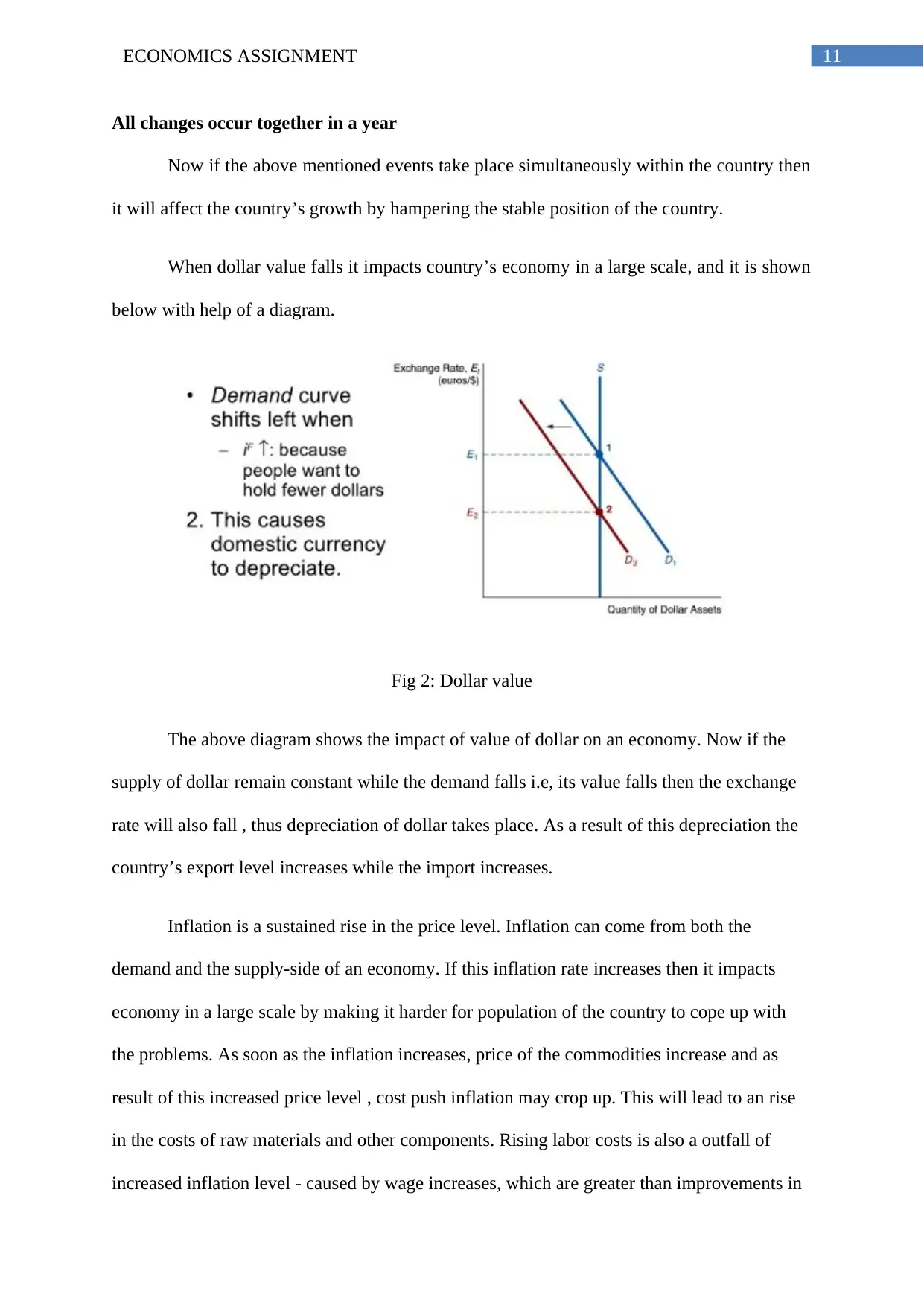
11ECONOMICS ASSIGNMENT
All changes occur together in a year
Now if the above mentioned events take place simultaneously within the country then
it will affect the country’s growth by hampering the stable position of the country.
When dollar value falls it impacts country’s economy in a large scale, and it is shown
below with help of a diagram.
Fig 2: Dollar value
The above diagram shows the impact of value of dollar on an economy. Now if the
supply of dollar remain constant while the demand falls i.e, its value falls then the exchange
rate will also fall , thus depreciation of dollar takes place. As a result of this depreciation the
country’s export level increases while the import increases.
Inflation is a sustained rise in the price level. Inflation can come from both the
demand and the supply-side of an economy. If this inflation rate increases then it impacts
economy in a large scale by making it harder for population of the country to cope up with
the problems. As soon as the inflation increases, price of the commodities increase and as
result of this increased price level , cost push inflation may crop up. This will lead to an rise
in the costs of raw materials and other components. Rising labor costs is also a outfall of
increased inflation level - caused by wage increases, which are greater than improvements in
All changes occur together in a year
Now if the above mentioned events take place simultaneously within the country then
it will affect the country’s growth by hampering the stable position of the country.
When dollar value falls it impacts country’s economy in a large scale, and it is shown
below with help of a diagram.
Fig 2: Dollar value
The above diagram shows the impact of value of dollar on an economy. Now if the
supply of dollar remain constant while the demand falls i.e, its value falls then the exchange
rate will also fall , thus depreciation of dollar takes place. As a result of this depreciation the
country’s export level increases while the import increases.
Inflation is a sustained rise in the price level. Inflation can come from both the
demand and the supply-side of an economy. If this inflation rate increases then it impacts
economy in a large scale by making it harder for population of the country to cope up with
the problems. As soon as the inflation increases, price of the commodities increase and as
result of this increased price level , cost push inflation may crop up. This will lead to an rise
in the costs of raw materials and other components. Rising labor costs is also a outfall of
increased inflation level - caused by wage increases, which are greater than improvements in
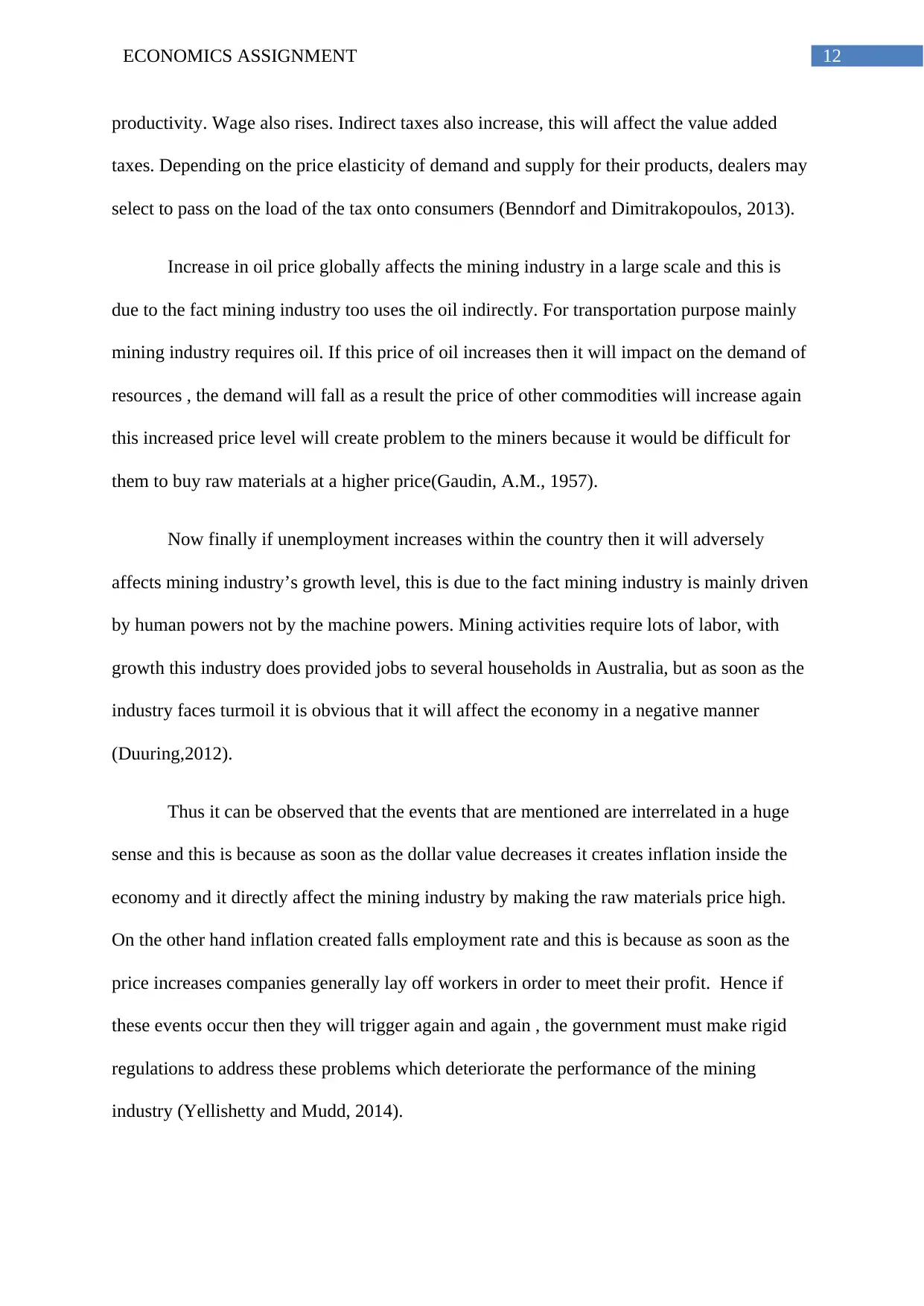
12ECONOMICS ASSIGNMENT
productivity. Wage also rises. Indirect taxes also increase, this will affect the value added
taxes. Depending on the price elasticity of demand and supply for their products, dealers may
select to pass on the load of the tax onto consumers (Benndorf and Dimitrakopoulos, 2013).
Increase in oil price globally affects the mining industry in a large scale and this is
due to the fact mining industry too uses the oil indirectly. For transportation purpose mainly
mining industry requires oil. If this price of oil increases then it will impact on the demand of
resources , the demand will fall as a result the price of other commodities will increase again
this increased price level will create problem to the miners because it would be difficult for
them to buy raw materials at a higher price(Gaudin, A.M., 1957).
Now finally if unemployment increases within the country then it will adversely
affects mining industry’s growth level, this is due to the fact mining industry is mainly driven
by human powers not by the machine powers. Mining activities require lots of labor, with
growth this industry does provided jobs to several households in Australia, but as soon as the
industry faces turmoil it is obvious that it will affect the economy in a negative manner
(Duuring,2012).
Thus it can be observed that the events that are mentioned are interrelated in a huge
sense and this is because as soon as the dollar value decreases it creates inflation inside the
economy and it directly affect the mining industry by making the raw materials price high.
On the other hand inflation created falls employment rate and this is because as soon as the
price increases companies generally lay off workers in order to meet their profit. Hence if
these events occur then they will trigger again and again , the government must make rigid
regulations to address these problems which deteriorate the performance of the mining
industry (Yellishetty and Mudd, 2014).
productivity. Wage also rises. Indirect taxes also increase, this will affect the value added
taxes. Depending on the price elasticity of demand and supply for their products, dealers may
select to pass on the load of the tax onto consumers (Benndorf and Dimitrakopoulos, 2013).
Increase in oil price globally affects the mining industry in a large scale and this is
due to the fact mining industry too uses the oil indirectly. For transportation purpose mainly
mining industry requires oil. If this price of oil increases then it will impact on the demand of
resources , the demand will fall as a result the price of other commodities will increase again
this increased price level will create problem to the miners because it would be difficult for
them to buy raw materials at a higher price(Gaudin, A.M., 1957).
Now finally if unemployment increases within the country then it will adversely
affects mining industry’s growth level, this is due to the fact mining industry is mainly driven
by human powers not by the machine powers. Mining activities require lots of labor, with
growth this industry does provided jobs to several households in Australia, but as soon as the
industry faces turmoil it is obvious that it will affect the economy in a negative manner
(Duuring,2012).
Thus it can be observed that the events that are mentioned are interrelated in a huge
sense and this is because as soon as the dollar value decreases it creates inflation inside the
economy and it directly affect the mining industry by making the raw materials price high.
On the other hand inflation created falls employment rate and this is because as soon as the
price increases companies generally lay off workers in order to meet their profit. Hence if
these events occur then they will trigger again and again , the government must make rigid
regulations to address these problems which deteriorate the performance of the mining
industry (Yellishetty and Mudd, 2014).
⊘ This is a preview!⊘
Do you want full access?
Subscribe today to unlock all pages.

Trusted by 1+ million students worldwide
1 out of 16
Related Documents
Your All-in-One AI-Powered Toolkit for Academic Success.
+13062052269
info@desklib.com
Available 24*7 on WhatsApp / Email
![[object Object]](/_next/static/media/star-bottom.7253800d.svg)
Unlock your academic potential
Copyright © 2020–2025 A2Z Services. All Rights Reserved. Developed and managed by ZUCOL.





